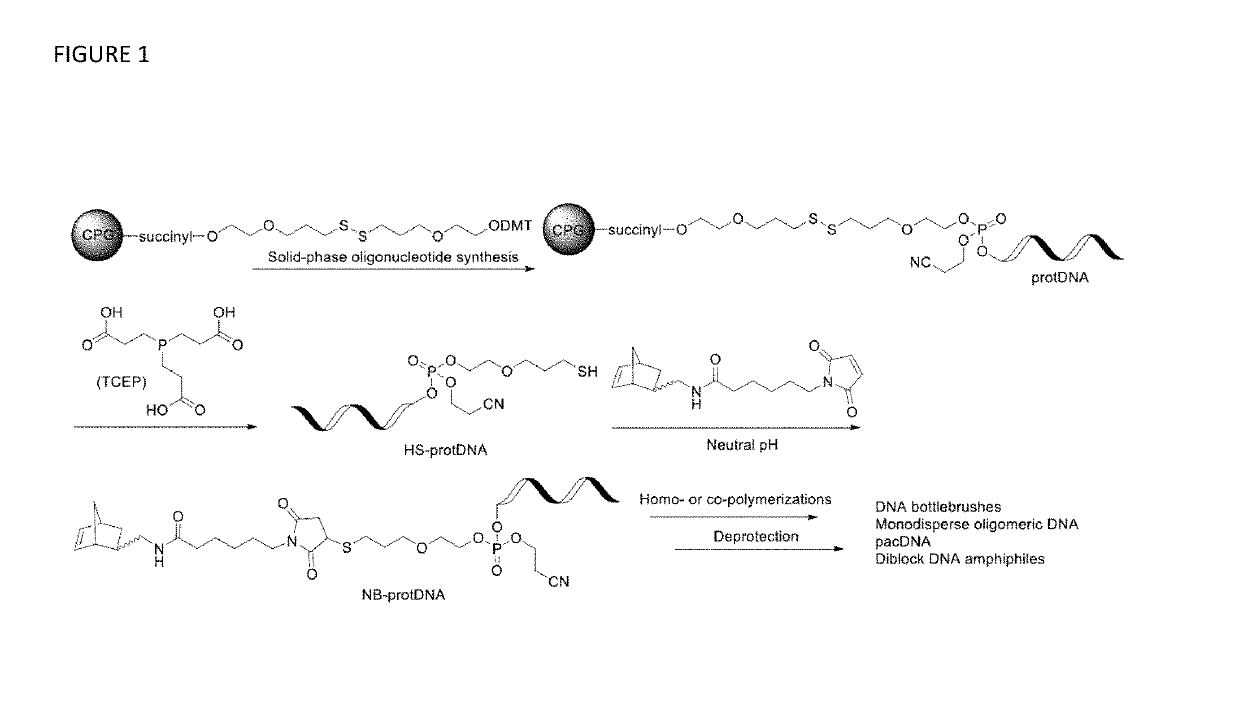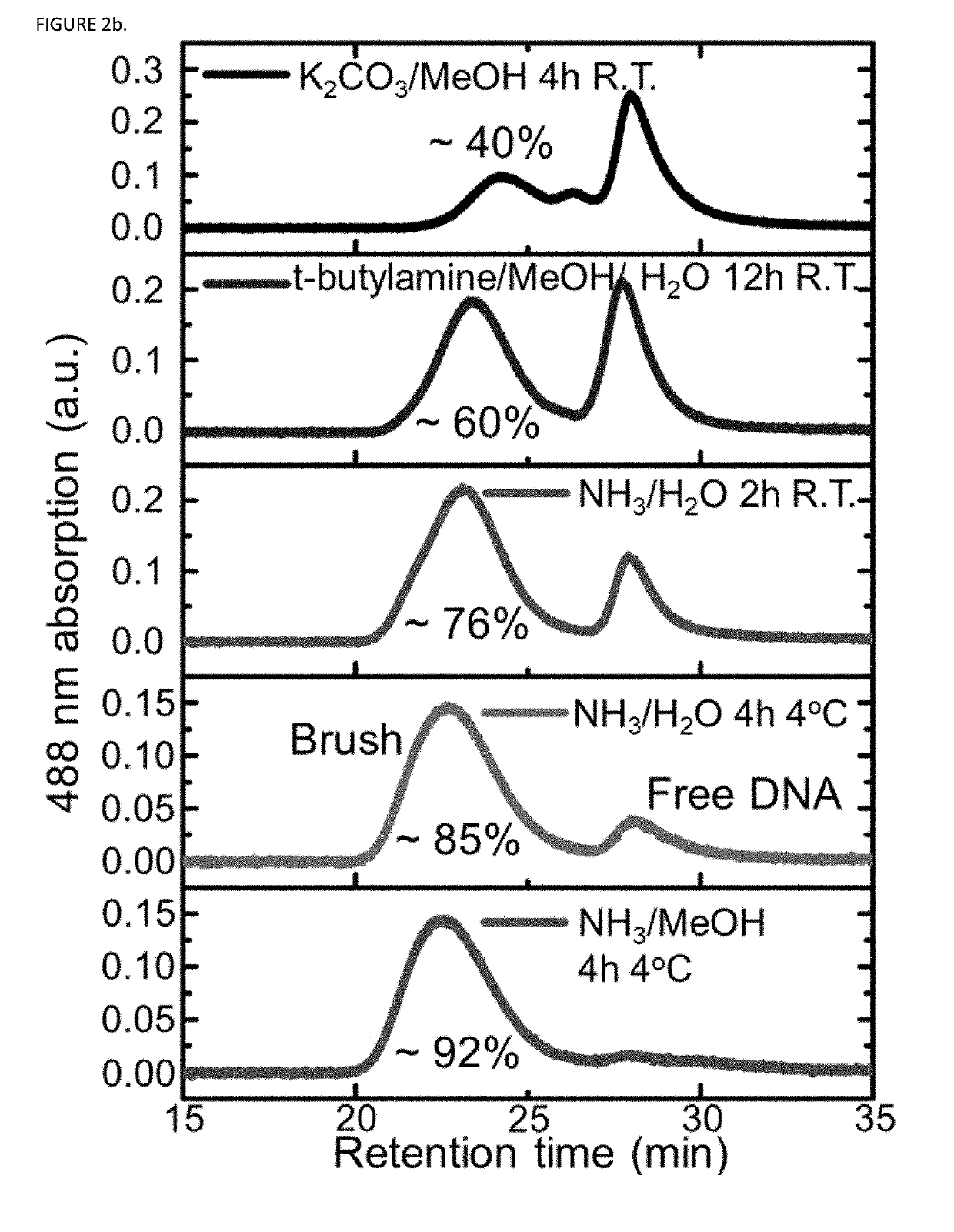Synthesis of high density molecular DNA brushes via organic-phase ring-opening metathesis (CO)polymerization
a dna bottlebrush and organic phase technology, applied in the field of new synthetic methods for oligonucleotide polymerization reactions, can solve the problems of complex structure involving multiple nucleic acid strands, difficult, if not impossible, to achieve on a rigid surface, amphiphilic conjugates, for example, are difficult, and the synthesis of multivalent dna constructs is difficul
- Summary
- Abstract
- Description
- Claims
- Application Information
AI Technical Summary
Benefits of technology
Problems solved by technology
Method used
Image
Examples
example 1
Synthesis of Norbornene-Maleimide Linker, 1
[0083]
DCC
[0084]6-Maleimidohexanoic acid (0.50 g, 2.37 mmol) and N,N′-dicyclohexylcarbodiimide (DCC, 0.59 g, 2.84 mmol) were dissolved in 5 mL of dichloromethane (DCM). In a separate vial, 5-norbornene-2-methylamine (mixture of isomers) (0.29 g, 2.37 mmol) was dissolved in 1 mL of DCM, and was added dropwise to the first vial containing the mixture. The reaction mixture was allowed to stir for 1 h at room temperature, followed by filtration to remove the urea byproduct. The filtrate was then concentrated and purified by silica gel column chromatography (hexane: ethyl acetate=2:1, v / v). The solvent was subsequently removed under reduced pressure to yield 1 as white solid (0.58 g, 77%). 1H-NMR (400 MHz, CDCl3): δ 6.65 (s, 2H), 6.11-6.14 (dd, J=2.7 Hz, 1H), 5.90-5.92 (dd, J=2.7 Hz, 1H), 5.79 (s, 1H), 3.45-3.50 (t, J=7.0 Hz, 2H), 2.83-3.01 (m, 2H), 2.76 (s, 2H), 2.11-2.16 (t, J=6.9 Hz, 2H), 1.76-1.83 (m, 1H), 1.53-1.67 (m, 6H), 1.38-1.41 (m, 1H)...
example 2
One-Pot Example 2
Synthesis of Norbornene-C12 Monomer, 2
[0085]
[0086]Exo-5-norbornene carboxylic acid (0.50 g, 3.62 mmol) and DCC (0.90 g, 4.36 mmol) were dissolved in 4 mL of DCM. In a separate vial, dodecylamine (812 μL, 0.67 g, 3.61 mmol) was dissolved in 2 mL of DCM, which was added dropwise to the first vial containing the mixture. The reaction mixture was allowed to stir for 1 h at room temperature, followed by filtration to remove the urea byproduct. The filtrate was then concentrated and purified by silica gel column chromatography (hexane:ethyl acetate=99:1 to 95:1, v / v). The solvent was removed under reduced pressure to yield 2 as white solid (0.81 g, 73%). 1H-NMR (400 MHz, CDCl3): δ 6.10-6.13 (dd, J=2.8 Hz, 1H), 6.07-0.09 (dd, J=2.8 Hz, 1H), 5.79 (s, 1H), 3.21-3.75 (t, J=6.6 Hz, 2H), 2.89-2.92 (m, 2H), 1.98-2.02 (m, 1H), 1.87-1.91 (dt, J=7.8, 3.4 Hz, 1H), 1.69-1.71 (d, J=8.3 Hz, 1H), 1.46-1.50 (m, 2H), 1.21-1.35 (m, 20H), 0.85-0.88 (t, J=7.0 Hz, 3H); 13C-NMR (400 MHz, CDCl3...
example 3
Synthesis of Norbornene-Pyrene Monomer, 3
[0087]
[0088]Exo-5-norbornene carboxylic acid (0.50 g, 3.62 mmol) and DCC (0.90 g, 4.36 mmol) were dissolved in 4 mL of DCM. In a separate vial, 1-pyrenemethylamine hydrochloride (0.97 g, 3.62 mmol) and triethylamine (520 μL, 0.38 g, 3.73 mmol) were dissolved in 2 mL of DCM, and the solution was added dropwise to the first vial containing the mixture. The solution was stirred at room temperature for 2 h. After filtration to remove the urea byproduct, the filtrate was washed with saturated sodium bicarbonate solution, 1 M HCl solution, brine, and then dried over sodium sulfate. The crude product was concentrated and purified by silica gel column chromatography (hexane: ethyl acetate=4:1, v / v). The solvent was subsequently removed under reduced pressure to yield 3 as slightly yellow solid (0.53 g, 42%). 1H-NMR (400 MHz, CDCl3): δ 8.10-8.24 (m, 5H), 7.99-8.07 (m, 3H), 7.92-7.95 (d, J=7.6 Hz, 1H), 6.09-6.12 (dd, J=2.8 Hz, 1H), 6.00-6.03 (dd, J=2.8...
PUM
| Property | Measurement | Unit |
|---|---|---|
| pH | aaaaa | aaaaa |
| diameter | aaaaa | aaaaa |
| number-average hydrodynamic diameters | aaaaa | aaaaa |
Abstract
Description
Claims
Application Information
 Login to View More
Login to View More - R&D
- Intellectual Property
- Life Sciences
- Materials
- Tech Scout
- Unparalleled Data Quality
- Higher Quality Content
- 60% Fewer Hallucinations
Browse by: Latest US Patents, China's latest patents, Technical Efficacy Thesaurus, Application Domain, Technology Topic, Popular Technical Reports.
© 2025 PatSnap. All rights reserved.Legal|Privacy policy|Modern Slavery Act Transparency Statement|Sitemap|About US| Contact US: help@patsnap.com



